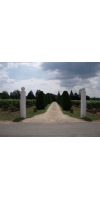Wine from Gravas

The Gravas Estate
Chateau Gravas was founded in 1789 and has been in the Bernard family for five generations. It is currently owned by Michel and Florence Bernard.
The name "Gravas" comes from "graves", a gravelly soil that perfectly suits the production of Sauternes wines.
The estate is superbly located in Barsac between Chateau Coutet, Chateau Climens and Chateau Doisy-Daene. The total production is 2,000 cases/year.
The Gravas Vineyard
There are 8 hectares (19.8 acres) of vineyard for the production of Sauternes. The soil is a mix of clay, sand and limestone. The 60 year-old vines are harvested by hand: the grapes are picked in successive passes. The wine is aged in both French and American oak barrels. There are 5 villages in Sauternes: Preignac, Barsac, Fargues, Beaumes and Sauternes.
Gravas Sauternes is a blend of 100% Sémillon.
The wine shows a lovely pale golden color with deep golden highlights. Round and well-balanced offering complex aromas of candied fruits backed up by a hint of exotic fruit (mango, guava) and white flowers. On the palate, it is ample and fleshy, leading into a silky and long finish.
The wine pairs well with white meats, scallops, exotic and spicy dishes, foie Gras, Roquefort blue cheese, chocolate desserts.
Gravas Sauternes is a blend of 100% Sémillon.
The wine shows a lovely pale golden color with deep golden highlights. Round and well-balanced offering complex aromas of candied fruits backed up by a hint of exotic fruit (mango, guava) and white flowers. On the palate, it is ample and fleshy, leading into a silky and long finish.
The wine pairs well with white meats, scallops, exotic and spicy dishes, foie Gras, Roquefort blue cheese, chocolate desserts.
- back
Selected Options
Wineries
Categories
Pricing
Countries
Regions
Grape Types
Wineries
Organic/Free Shipping
Stonestreet Estate Vineyards Rockfall Cabernet Sauvignon is made from Cabernet Sauvignon.
Sourced from one of our highest elevation vineyards, the 2017 Rockfall Vineyard Cabernet Sauvignon features a true wildness that expresses the rugged growing site 2,000ft above the fog line. Elegant aromas of blueberries, cassis, graphite and black tea with complex undercurrents of baking spices. This wine balances power with elegance through to its savory palate with a generous structure and ample tannins. The structure of this wine allows for many years of cellar aging to continue to bring out nuanced flavors and complexity.
Review:
The Rockfall Vineyard is between 2,000 and 2,200-feet in elevation, and the wine that originates there is powerful and concentrated in style, with robust red-fruit and mineral tones. Herbal and classic, it shows elegance and integrated oak and tannin within its context of intensity and structure. Enjoy best from 2027–2037. Virginie Boone
-Wine Enthusiast 96 Points
Charles Heidsieck Vintage Brut is made from 57% Pinot Noir, 43% Chardonnay.
A beautiful golden robe offers glints of green accentuated by a delicate, dynamic effervescence. The initial nose introduces intense toasted and smoky notes along with ripe fruit. When swirled in the glass, the nose takes on a heartier dimension with touches of apricot and vineyard peaches. The aromatic concentration, due to a heat wave of several weeks, is reminiscent of the summer sun. The attack is taut and decisive. the creamy texture, the crisp fruitiness and spiced notes of cinnamon, licorice and pepper are the hallmark of the House style.
Review:
Aged for eight years on the lees before disgorgement, the Champagne is deliciously toasty with acidity and fine dryness.
-Wine Enthusiast 96 Points
Disgorged in January of 2023, the 2013 Champagne Millésime Brut was the last vintage from the cellar master for Heidsieck prior to Cyril Brun. The 2013 Champagne Millésime Brut is a bright straw yellow color and is based on the crus of Les Mesnil, Avize, Averney, and Aÿ. It’s fresh with aromas of wet stones, fresh quince, and fresh jasmine flowers. It has a chalky and focused texture, with ripeness to balance it out, and a long, graceful finish. At this stage, it feels more forward with 57% Pinot Noir and the rest Chardonnay. A more mineral-tinged expression, it has a lot of charm and the promise of longevity over the coming two decades. Drink 2024-2044. It will be interesting to see how the Pinot shows itself over time. 8 grams per liter dosage.
-Jeb Dunnuck 95 Points

-150x300.jpg)



